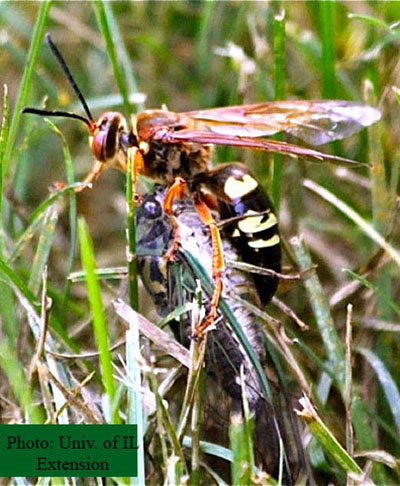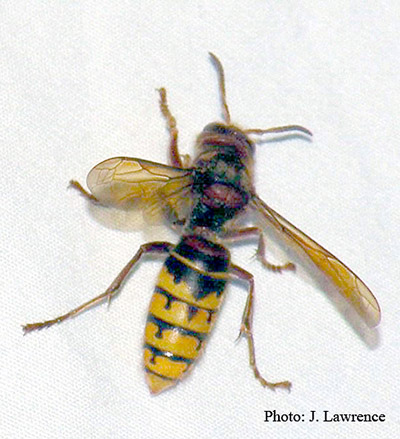Issue 10, July 14, 2014
Cicada Killer and European Hornet
We have been receiving reports of large wasps in recent weeks that some people have "identified" by using the Internet as Asian giant hornet. This is confounded by several news stories, including some in Illinois, on supposed sightings of the Asian giant hornet. From what I can tell, there have been no confirmed sightings of Asian giant hornet in the US. There are no US photographs or collected specimens. Two samples sent to me earlier this year thought to be Asian giant hornets turned out to be European hornets. Other sightings have been determined to be cicada killers. Please send me specimens and/or photos of what is thought to be Asian giant hornets in Illinois.
Cicada killers are about 2 inches long and black to red, with yellow banded markings on the abdomen. The head and transparent wings are reddish brown. Cicada killer emergence is timed with dogday cicada emergence. These insects are considered to be beneficial because they exert a form of biological control on cicada populations. However, the excavating and burrowing in open dry ground for nest construction can be a nuisance for gardeners and many fear the adults in flight. Cicada killers are considered to be non-aggressive.

Cicada killer with annual cicada.
It is the manner in which the male conducts himself that makes him feared. When you invade his territory, a male may aggressively approach to investigate and rule out any competition. Despite his insect equivalent of chest pounding, males are unable to sting. The females are the ones capable of stinging but is rarely done because she lacks the instinct to guard their nest like the honey bee.
Once the female cicada killer has found and paralyzed a cicada, she will carry it back to her underground nest. The female places her prize in a nest cell, lays an egg on it, and seals up the cell. The larva hatches in a few days and begins to feed upon the still living but paralyzed cicada before forming a cocoon to pupate during winter and early spring. Plant ground covers and grass to avoid bare spots, put down mulch and use irrigation to deter nesting. Individual females can be killed by placing carbaryl dust (Sevin Dust) near the nest opening. They will pick up the dry dust and be killed through grooming. When the females are gone, the males will go elsewhere.

European hornet.
European hornets are about one inch long with black and yellow banded abdomens. The black bands extend into V- to arrow-shaped markings down the upper side of the abdomen. They nest in tree trunks and other hollow areas. Although large and imposing, their main aggression consists of head butts, so they sometimes fly into people to get them to move. Like cicada killers, one typically has to step on one bare-footed or grab one bare-handed to get stung. Unlike other bees and wasps that are only out during the day, European hornets are attracted to lights at night, being commonly seen flying into porch light bulbs and vehicle headlights. (Phil Nixon and Kelly Alsup)
Authors:
Phil Nixon
Kelly Allsup